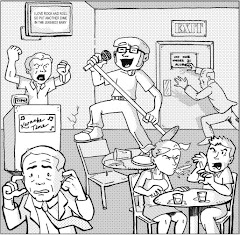
So, considering these tumultuous political times, I thumbed through the unread, leftover issues from the now defunct A Comic A Day: Year Two, which quaintly fill a small comic book box on the side of my bed, and I found The Night Club #3, the cover of which reflects many bipartisan fears of our country's immediate future. Yes, that's the devil at the Presidential pulpit. Whether the devil was raised in Hawaii or Alaska is entirely up to you, though that both of the pseudo-celebrities of this election were raised in the two states not connected to the nation's mainland is suspect no matter what side of the fence you straddle . . .
I pulled The Night Club #3 from a twenty-five cent back issue bin several months ago and hoped to read it for Election Day, so the relaunch of A Comic A Day possessed me (Get it?) to dust it off on Friday, and while its plot wasn't as engaging or substantial as I'd hoped, it does reflect a few trends common in politically-minded comics: (1.) The Conspiracy Theory, and (2.) The Righteous Rebels. In this case, "righteous" is the appropriate term, as Reverend Walter Bishop and his "rag-tag misfits" combat the devil, dubbed Screwbarb, and his plot to hasten Armageddon apparently through American politics. At the end of this issue, the President is horrifically assassinated (okay, if you must know, a demon flies through his chest -- so much for the good ol' days of grassy knolls), and the Vice President, deep in Screwbarb's pocket, assumes office. You betcha.
Now, to quite a few folks' chagrin, religion and politics really are eternal bedfellows, whether or not the Constitution has ever clearly distinguished church from state; further, I liken religion and politics to the proverbial Siamese twins of human philosophy, with two heads and respective thought processes designed to deal with mankind's inherent need for law and order differently. Hyperbole aside, though, I hope the two are never so intertwined that the devil, if he exists, infiltrates the White House and instigates the apocalypse through gay rights legislation, or something. I don't remember reading about that in the book of Revelation. In fact, depending on one's interpretation of John's apocalyptic allegory, the United States is scarcely mentioned at all, so our persistent belief that we've birthed the Anti-Christ or will play Ground Zero to the end of the world is arguably the most nationalistic trite ever. "A shining city on a hill?" Perhaps . . . but overlooking the lake of fire? Not likely.
What's the point of all this? The Night Club asks us to look at the big picture. The grand scheme of this election season has been episodic at best, packaging the most critical events into makeshift installments not unlike seasons of one's favorite television show. This Vice Presidential chapter might not seem as important come Tuesday's Presidential debate (round two), but The Night Club #3 reminds us that we're just a flying demon away from 1963 all over again. Of course, the night between Election Day and its results will seem like the longest summer between a series' season finale and fall premiere, the anticipation will be that great, but in the meantime citizens' selection processes shouldn't be so compartmentalized. If it were a TV series, I'd encourage everyone to have a Presidential election marathon the night before voting day, to remind themselves of their chosen candidates' record before becoming leader of the free world was on their to-do list, to experience the twists and turns in their characters' development toward becoming the protagonists we see them as now. Then, remember that this story is very real.
Hopefully the part where the devil takes the podium stays the stuff of fiction.
The Night Club #3 was published in April, 2006, by Image Comics, and was written by Mike Baron, illustrated by Robbi Rodriguez, colored by Russ Lowery, lettered by Marshall Dillion, and edited by Marshall Dillion and Chris Crank.


